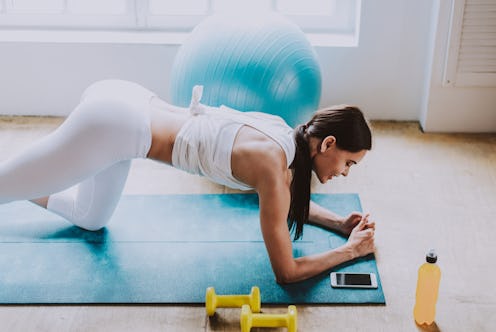Wellness
The Benefits Of Frog Pose, Yoga's Super Intense Hip Opener
The mat is your lily pad.

While there are a ton of amazing hip-opening stretches in yoga, few of them are quite as intense as frog pose. While this move looks innocent enough at first — just like a frog on a lily pad — it really does get in there and stretch muscles you didn’t even know you had.
Frog pose, or mandukasana, is one of the best hip-opening poses you can do, says Andrew Sealy, a yoga instructor with ISSA Yoga & Wellness Academy. It involves lying on your stomach with your knees spread apart — again, like a frog — to reach your hips, groin, back, glutes, and even your core.
“Frog pose is a deep hip stretch, so it’s excellent for those with tight hips from sitting at a desk or in a car, or from other forms of exercise like running or cycling,” Sealy tells Bustle. “When practiced regularly, frog pose can help stretch your hip flexor muscles, and it can also loosen the muscles in your lower back to help alleviate lower back pain.”
Frog pose is challenging, especially for beginners, but like all of the stretches in yoga there are plenty of ways to modify it to make it your own. To soak up its many benefits, keep reading below for more info on frog pose, including how to give it a try.
How To Do Frog Pose
Here, Sealy explains how to do frog pose using good form. He recommends using your mat or a blanket for extra padding under your knees.
- Start in a tabletop position.
- Take slow, deep breaths.
- Begin to widen your knees towards the edges of your mat.
- Lower your hips closer to your mat as far as you can go without feeling any pain.
- Keep your knees bent 90 degrees.
- Keep the insides of your foot, ankles, and knees down on the mat.
- As you exhale, slowly lower onto your forearms.
- Keep your arms shoulder-width apart and your shoulders stacked over your elbows.
- Engage your core and lengthen through your spine.
- Continue to sink your hips closer to your mat.
- Feel a stretch in your hips and groin.
- To get out of frog pose, slowly bring your feet back to the midline of your body and move back to tabletop position.
- Bring your feet together and stretch your arms forward into a child’s pose.
How To Modify Frog Pose
If frog pose is too much, try rolling up the edges of your yoga mat to create extra cushioning under your knees. “The pose is intended to provide a deep stretching sensation, but if you feel true pain, you can also bring your knees closer together,” Sealy says.
For beginner stretchers, he recommends starting with the less-intense half-frog pose as a way to ease in. To try a half-frog, lie on your stomach and place your forearms in front of you for sphinx pose. Let your legs stretch straight back behind you. Straighten your right arm to push your torso up as you reach back with your left hand to grab your left foot. You’ll feel a nice stretch in your hips.
If you have flexible hips and think frog pose is easy peasy, feel free to deepen the stretch by walking your forearms further out in front of you. “You can also progress by bringing your chest and chin to the floor,” Sealy says. Take deep breaths as you go — and only try it if it feels right.
Common Mistakes To Avoid In Frog Pose
According to Sealy, it’s super common to hold your breath while in frog pose, because it really is that intense. To melt into the stretch — and actually enjoy it — it helps to focus on deep breathing by inhaling slowly through your nose and then out through your mouth the entire time.
Another common mistake is forcing frog pose by going deeper than you want to in order to make it look a certain way. “This is when the ego takes over,” Sealy says. “Like any pose, you have to listen to your body and never force a posture.” Instead, modify the stretch as much as you need to as you improve your flexibility — and you’ll be a frog before you know it.
Studies referenced:
Chang, DG. (2016). Yoga as a treatment for chronic low back pain: A systematic review of the literature. J Orthop Rheumatol. PMID: 27231715; PMCID: PMC4878447.
Source:
Andrew Sealy, yoga instructor with ISSA Yoga & Wellness Academy
This article was originally published on